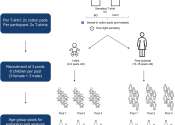Adolescence (lat adolescere, (to) grow) is a transitional stage of physical and mental human development that occurs between childhood and adulthood. This transition involves biological (i.e. pubertal), social, and psychological changes, though the biological or physiological ones are the easiest to measure objectively. Historically, puberty has been heavily associated with teenagers and the onset of adolescent development. In recent years, however, the start of puberty has had somewhat of an increase in preadolescence (particularly females), as well as an occasional extension beyond the teenage years (typically males). This has made adolescence less simple to discern.
The end of adolescence and the beginning of adulthood varies by country and by function, as even within a single country there will be different ages at which an individual is considered mature enough to be entrusted with particular tasks, such as driving a vehicle, having sexual relations, serving in the armed forces, voting, or marrying. Also, adolescence is usually accompanied by an increased independence allowed by the parents or legal guardians and less supervision, contrary to the preadolescence stage.







